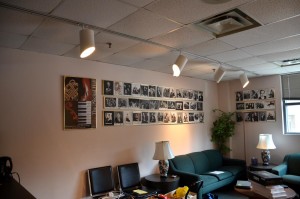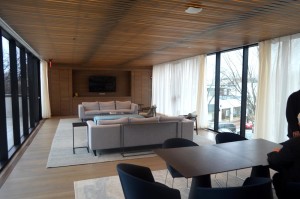Did You Know – Who Is Asking?
By Robert Davis, FASTC

A common back stage Green Room. A place to relax near the stage while waiting to go onstage. Photo by Paul Sanow, ASTC
It’s essential to know who is asking.
When performers ask for a green room, I know exactly what they mean. They mean something related equally to a Strategic Air Command pilot ready room and the Noh Theatre Mirror Room, both of which are places to wait in a high state of readiness for an all-consuming task. In a theatre, this type of Green Room has a galley kitchen, performance monitor speakers, stage manager page speakers, durable lounge furniture and direct access to both sides of the stage.
When donors ask for a Green Room, I know exactly what they mean. They mean a reception room with silk upholstered sofas, Kilim carpets, chinoiserie lamps, a buffet table and, most importantly, private toilets. This is the donor’s lounge before the performance and during intermission, and is where the invitation-only catered reception is held for VIP talent after the performance. This room might need to connect to both the backstage and public circulation systems, which then puts strict constraints on where it can be located within the building.

The Donor Lounge at Writer’s Theatre, Glencoe, IL. While not named “Green Room”, this is one iteration of an exclusive space for donors and private functions. This one opens to a terrace. Photo by Paul Sanow, ASTC
In some theatres one space serves both functions, which is a stretch. Other theatres have one of each type of room, in which case the two different Green Rooms need two very different locations and attach to the circulation paths in two very different ways.
If one failed to notice who asked for the Green Room, one might provide exactly the wrong type of space. This principle of understanding “Who is asking?” can and should be applied to every request for space in a performance facility.
There are plenty of theories, but unfortunately no evidence for why either is called a Green Room. That seems to be lost to history.
Disclaimer: Any views or opinions expressed in this article are solely those of the author and do not necessarily represent those of the American Society of Theatre Consultants. This article is for general information only and should not be substituted for specific advice from a Theatre Consultant, Code Consultant, or Design Professional, and may not be suitable for all situations nor in all locations.


